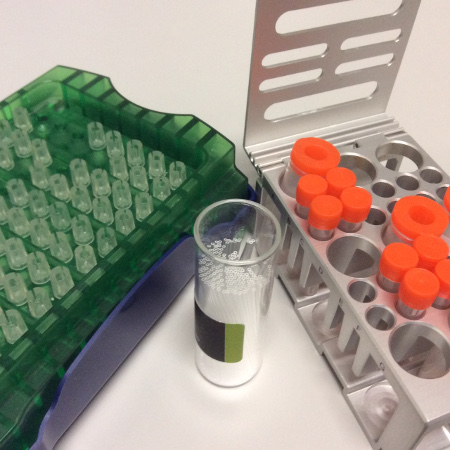Analyse biophysique des interactions moléculaires
Ce service de PBSIM offre un ensemble d’équipements de pointe pour la caractérisation de complexes moléculaires et le criblage ou l’analyse d’interactions moléculaires, en solution ou sur support solide.
Ces outils sont particulièrement adaptés à l’étude des complexes de type :
- protéine/protéine
- protéine/acide nucléique
- protéine/petite molécule
- protéine/détergent
Accessibilité
Académiques et industriels
Coût
A définir en fonction du projet.
Comment faire une demande ?
- Compléter le formulaire
en cliquant “Marseille” à partir de l’item “Biophysical facility” - Contact AFMB : Maria Mate
Equipement spécifique
- Titration calorimétrique isotherme (ITC) : MicroCal iTC200 (Malvern Panalytical)
- Thermophorèse à micro échelle (MST) : Monolith NT.115 (NanoTemper Technologies GmbH)
- Gel filtration analytique/diffusion statique de la lumière multi angle/ réfractométrie (SEC-MALS) :
- HPLC Ultimate 3000 (Thermo Scientific)/ Dawn 8 (Wyatt)/ Optilab (Wyatt)
- Interférométrie (BLI) : Octet RED96 et Blitz (ForteBio, Molecular Devices)
- Gel filtration analytique/Detection par fluorescence (FSEC) : HPLC Dionex/détecteur de fluorescence (Thermo Scientific)
- Nano differential scanning fluorimetry (nanoDSF) : Tycho (NanoTemper Technologies GmbH)
- Diffusion dynamique de la lumière (DLS) : Zetasizer (Malvern Panalytical)
- Dichroïsme circulaire (CD) : J-810 (Jasco)
Contacter le groupe
Publications
- Fuchsbauer O, et al. (2019) Cas9 Allosteric Inhibition by the Anti-CRISPR Protein AcrIIA6. Mol Cell. 2765(19):30697-5.
- Bauer L, et al. (2019) Fluoxetine Inhibits Enterovirus Replication by Targeting the Viral 2C Protein in a Stereospecific Manner. ACS Infect Dis. 5 (9):1609-1623
- Tsika AC, et al. (2019) Deciphering the Nucleotide and RNA Binding Selectivity of the Mayaro Virus Macro Domain. J Mol Biol. 431(12):2283-2297
- Nguyen PC, et al. (2018) Biochemical and Structural Characterization of TesA, a Major Thioesterase Required for Outer-Envelope Lipid Biosynthesis in M. tuberculosis. J Mol Biol 430 : 5120-5136
- Nguyen VS, et al. (2018) Towards a complete structural deciphering of Type VI secretion system. Curr Opin Struct Biol 49 77-84
- Leone P, et al. (2018) Type IX secretion system PorM and gliding machinery GldM form arches spanning the periplasmic space. Nat Commun 9 429
- Nguyen VS, et al. (2017) Type VI secretion TssK baseplate protein exhibits structural similarity with phage receptor-binding proteins and evolved to bind the membrane complex. Nat Microbiol 2 17103
- Ravachol J, et al. (2016) Mechanisms involved in xyloglucan catabolism by the cellulosome-
- Foos N, et al. (2015) A flexible extension of the Drosophila ultrabithorax homeodomain defines a novel Hox/PBC interaction mode. Structure 23(2):270-9
- De la Cruz MA, et al. (2013) A toxin-antitoxin module of Salmonella promotes virulence in mice. PLoS Pathog. 12:e1003827
- Mate MJ, et al. (2012) Crystal structure of the DNA-bound VapBC2 antitoxin/toxin pair from Rickettsia felis. Nucleic Acids Res 40 3245-58
- Douzi B, et al. (2011) Deciphering the Xcp Pseudomonas aeruginosa type II secretion machinery through multiple interactions with substrates. J Biol Chem. 40792-801
- Felisberto-Rodrigues C, et al. (2011) Towards a structural comprehension of bacterial type VI secretion systems : characterization of the TssJ-TssM complex of an Escherichia coli pathovar. PLoS Pathog. 7 e1002386
- Habchi J, et al. (2011) Characterization of the interactions between the nucleoprotein and the phosphoprotein of Henipavirus. J Biol Chem. 13583-602
- Sciara G et al (2010) Structure of lactococcal phage p2 baseplate and its mechanism of activation. Proc Natl Acad Sci USA. 107 6852-7
- Veesler D, et al. (2009) Production and biophysical characterization of the CorA transporter from Methanosarcina mazei. Anal Biochem. 388 115-21.





